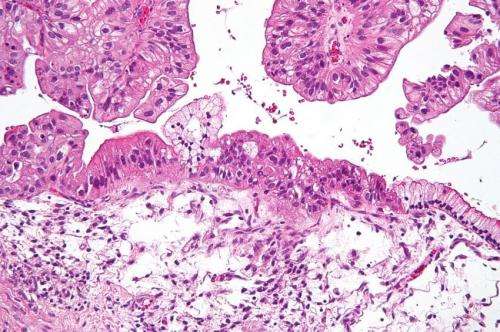This article has been reviewed according to Science X's editorial process and policies. Editors have highlighted the following attributes while ensuring the content's credibility:
fact-checked
peer-reviewed publication
trusted source
proofread
Scientists discover potent and selective inhibitors for ovarian cancer treatment

To identify potential therapeutic targets and preclinical drug candidates for the treatment of ovarian cancer, researchers led by Tan Li from the Shanghai Institute of Organic Chemistry of the Chinese Academy of Sciences have developed novel small molecule inhibitors of CPSF3, a key module of the cleavage and polyadenylation specificity factor (CPSF) complex that catalyzes pre-mRNA splicing and regulates transcription termination.
This work was published in Science Advances on Nov. 22.
Ovarian cancer is the deadliest gynecological cancer and is often diagnosed at a late stage. In treating ovarian cancer, surgery and systemic chemotherapy can modestly improve the survival rate, while targeted therapies with PARP inhibitors are effective in a limited number of ovarian cancer patients.
Ovarian cancer is often characterized by frequent copy number alterations and dysregulated gene expression, making transcription a potential point of attack for drug therapies.
In collaboration with Zhuang Guanglei's group at Renji Hospital, Shanghai Jiao Tong University School of Medicine, Tan and his team systematically investigated the regulatory functions of the CPSF complex in ovarian cancer and showed that ovarian cancer is uniquely dependent on transcription termination machinery, where the endonuclease activity of CPSF3 is indispensable.
With these findings in hand, the researchers aimed to validate CPSF3 as a potential therapeutic target by searching for small molecule inhibitors that could pharmacologically perturb the enzymatic activity of CPSF3 in cells and in vivo.
Based on reported antimicrobial or antitumor agents that share a common benzoxaborole moiety, Dr. Tan and his collaborators speculated that oxaborole groups could coordinate with the catalytic zinc ions of CPSF3.
Using this knowledge, they eventually developed potent, selective, bioavailable, and tolerable CPSF3 inhibitors including HQY426. The latter inhibitor and its analogs exhibited very potent antiproliferative effects in various ovarian cancer cell lines and effectively suppressed ovarian cancer tumor growth in vivo as a single agent or in combination with cisplatin or PARP inhibitors.
In comparison, previously reported CPSF3 inhibitors were almost inactive. Furthermore, point mutation of key residues in the catalytic site of CPSF3 was sufficient to confer resistance to HQY426 and analogs in ovarian cancer cells, further confirming the specificity of these targeted inhibitors.
In conclusion, the discovery of these inhibitors helps to establish CPSF3-dependent transcription termination as a key mechanism of ovarian cancer that is susceptible to therapeutic intervention. It also provides a promising class of boron-containing leads for targeted anticancer drug development.
More information: Peiye Shen et al, Therapeutic targeting of CPSF3-dependent transcriptional termination in ovarian cancer, Science Advances (2023). DOI: 10.1126/sciadv.adj0123




















